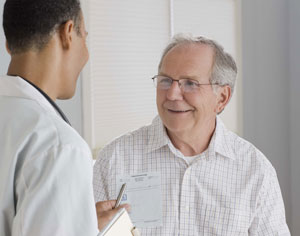Exploring the Connection between Prostate Health and Testosterone
There is a strong connection between prostate health and testosterone that every man should understand. The walnut-sized prostate gland is located below the bladder and surrounds the urethra, and it produces the fluid that carries sperm during ejaculation. This important gland may increase in size to that of an apricot by the time a man is in his forties, and a lemon by age sixty – when up to 80 percent of men may have some form of urinary difficulty.
BPH – benign prostatic hyperplasia – has nothing to do with cancer and occurs when an enlarged prostate squeezes the urethra, in turn causing urine flow to weaken and slow. This condition may affect more than half of men over sixty, and up to 90 percent of those in their seventies and eighties. In addition to causing poor urine flow, BPH is also responsible for:
- Urinary urges
- Incomplete voiding or emptying of the bladder
- Urinary discomfort or pain
- Frequent waking to urinate at night
- Reduced urine flow
- Inability to urinate
- Urinary blockage
Since no pain is associated with BPH, pain of any type could indicate some form of an infection being present. Many of the problems affecting the prostate can be traced back to issues with testosterone metabolism and aromatization.
The Role of Prostate for Hormonal Balance
There is a crucial connection between prostate health and testosterone problems that can be affected by outside influences, such as hormone disrupters. In this case, synthetic estrogen-mimicking molecules (xenoestrogens) disrupt the balance between estrogen and testosterone in the body. One purpose of the prostate gland is to act as a filter for the semen, removing impurities and toxins. When this balance is offset, unwanted prostate growth can occur as a result of an excess level of estrogen.
Estrogens may also play a role in the development of both benign and cancerous prostate cells. There is some concern that severe BPH can lead to other, more serious health problems, including cancer if left untreated. As with any adverse or unusual symptoms, those mentioned in the previous section should be checked out by a doctor.
Aromatization and Prostate Health
Testosterone combines with the enzyme aromatase to produce estrogen, a hormone that is essential for stimulating the brain to trigger normal sexual function. There is a proportionate increase in estrogen levels as a man ages comparable to the decline in testosterone levels. The following types of stress can also lead to a decline in male testosterone levels and female progesterone loss:
- Emotional
- Physical
- Chemical
Since aromatase is produced in larger quantities in older men, this further shuts down the functions associated with testosterone, including the following:
- Muscle growth
- Sexual desire
- Hair growth
- Regulation of body fat
Although women do not have a prostate gland, they are still at risk of adverse issues due to aromatization. This enzyme is found in estrogen-producing cells in the ovaries and placenta in women, testicles in men, and in the brain, adrenal glands, and fat tissue in both genders. Aromatase converts both testosterone and progesterone into estrogen. This can increase the risk of colon and prostate cancer in men. See the page “Low Testosterone and Prostate Cancer” for more information on this subject.
Poor Testosterone Metabolism and Prostate Health
When you have poor testosterone metabolism, prostate growth can become an issue. Although the majority of men will suffer from an enlarged prostate at some point in their lives, the causes of this occurrence are not always clearly understood. Aging is often viewed as a primary reason, and that brings a close examination of the effect that decreased testosterone levels may have on this condition.
More and more, it seems that when looking at overall prostate health, testosterone levels play a key role in this function. A decrease in testosterone production is normal with age, and that, in turn, increases estrogen levels in a man’s body. Elevated DHT can also be problematic.
DHT (dihydrotestosterone) is a hormone that is synthesized from testosterone by the prostate gland, hair follicles, adrenal glands, and testes by an enzyme known as 5-alpha reductase. DHT production does not slow down when testosterone levels decline, and this can cause a buildup of high amounts in the prostate – causing the growth of prostate cells.
Comparing prostate health and testosterone/DHT ratios with estrogen shows the need to minimize the aromatization process in order to maintain healthy hormone levels.
Natural Ways to Aid Hormone Metabolism

Helpful ways to increase hormone metabolism include:
- Consuming cruciferous vegetables such as cabbage, cauliflower, and broccoli
- Avoiding grapefruit
- Increasing the intake of zinc
- Losing weight
- Avoiding alcohol consumption
Testing and Treatment for Decreased Testosterone Levels and Prostate Health
There was, in the past, the thought process that testosterone therapy for Low T could increase the risk of prostate cancer. Not only has research in the past few years discounted that fact, but it is also now believed that the decrease in testosterone levels may be responsible for problems associated with prostate growth and other concerns.
When trying to improve adverse symptoms linked to inferior prostate health, testosterone treatment has actually been shown to decrease PSA numbers, reduce urinary symptoms, and provide some shrinkage to the prostate gland.
The following tests are typically done to check prostate health:
- Blood tests – this is typically one of the first things that a doctor will order. Free and total testosterone levels, PSA, estradiol, CBC, thyroid, IGF-1, cholesterol, and other essential markers will be checked.
- Rectal exam – this enables the doctor to feel the size of the prostate gland, as well as check for lumps. This is often included in the physical exam of men over the age of forty – especially if there are any concerns regarding urinary flow.
- Urine test – this can show if a urinary tract infection is possible, especially if a man is experiencing pain during urination.
- Ultrasound exam – sound waves create an image of the prostate on a video monitor if there is a concern that something is not right.
Treatment can be accomplished in a number of ways, and will depend on the final diagnosis. If the concern is low testosterone and higher than ideal estrogen levels, the doctor will probably order testosterone treatment with Anastrozole to inhibit the estrogen conversion process.
Other options may include finasteride to slow and reduce the growth of the prostate gland, as well as surgery to widen the urethra by trimming away excess pituitary gland tissue. Surgery is not a cure, as enlarged prostate can reoccur, as well as lead to kidney stones, kidney damage, and urinary tract infections. If Low T is present, it is recommended to try this treatment as the first option.
National HRT is a hormone replacement therapy clinic for men and women throughout the US. Complimentary, confidential consultations are provided by our medical advisors to adults with concerns about hormonal deficiencies and imbalances.
- The Asco Post
- MedicalExperess
- U.S.Pharmacist
- Michaud JE, Billups KL, Partin AW. Testosterone and prostate cancer: an evidence-based review of pathogenesis and oncologic risk. Ther Adv Urol. 2015;7:378–87.


